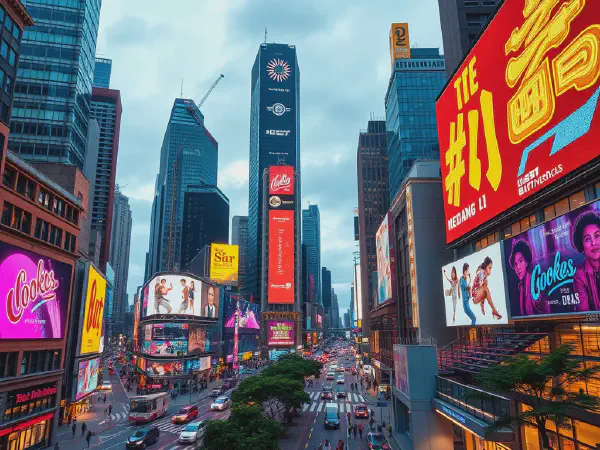Exploring the Impact of Gigantic Signs in Urban Spaces

The Impact and Insights of Gigantic Signs
Gigantic Signs have become a staple in urban landscapes, often serving as beacons that capture both attention and imagination. These bold displays are not just physical structures; they symbolize the larger-than-life aspects of modern advertising and communication. Standing tall and vibrant, Gigantic Signs have the capability to transform city environments and evoke emotional responses from passersby.
The evolution of Gigantic Signs can be traced back to the early 20th century, where businesses used illuminated signs to attract customers. Today, these signs are crafted using innovative materials and advanced technology, allowing for an array of designs that can be tailored to the specific needs of brand messaging. Gigantic Signs thus contribute not only to advertising but also to the aesthetic landscape of cities.
Moreover, Gigantic Signs are instrumental in captivating audiences and enhancing brand recognition. Their sheer size demands attention, making them ideal for marketing campaigns that aim for a memorable impact. As the focus on outdoor advertising grows, the prominence of these large displays continues to rise, making them a crucial aspect of the advertising industry.
Additionally, Gigantic Signs reflect cultural significance, as they often incorporate local motifs, traditions, and histories into their design. They serve as landmarks, providing identity and continuity within fast-evolving cityscapes. As these signs become intertwined with local culture, they take on a life of their own, fostering community connections and pride.
With the continuous advancements in technology and materials, the future of Gigantic Signs promises to be visually stunning, if not transformative. As sustainability becomes a priority, innovative sources of energy and resource-efficient manufacturing processes are increasingly being incorporated to ensure these signs meet modern ecological standards, hence the relevance of Gigantic Signs in contemporary society cannot be overstated.
Design Trends of Gigantic Signs
Innovative materials used in gigantic sign design include lightweight composites, eco-friendly options, and high-resolution digital screens. These materials not only pad the signs' aesthetic quality but also ensure longevity and sustainability. The incorporation of materials like recycled metals and organic compounds is on the rise, reflecting the industry's shift towards environmentally responsible practices.
The role of digital technology in gigantic signs has revolutionized how messages are conveyed. Digital billboards can exhibit moving images, real-time updates, and interactive content, drastically elevating audience engagement. This technology allows companies to update their ads instantly, responding to trends and circumstances in a manner that traditional static signs simply cannot.
Sustainability in gigantic sign manufacturing is becoming increasingly critical. Sign manufacturers are exploring ways to reduce their carbon footprint through energy-efficient lighting such as LED and solar power, as well as sourcing sustainable materials. This trend reflects a broader societal shift towards greener practices, catering to consumers' growing preference for environmentally conscious companies.
Color theories applied to gigantic sign aesthetics play a crucial role in capturing attention and conveying messages. For instance, warm colors are generally known to evoke feelings of excitement and urgency, while cooler tones can inspire calmness and trust. Designers meticulously select color combinations that align with brand identity as well as the emotional response they aim to elicit from viewers.
Gigantic Signs in Advertising
Case studies of successful gigantic advertising campaigns abound, with brands like Coca-Cola and Nike utilizing massive billboards in strategic locations to maximize visibility. These campaigns demonstrate how well-placed gigantic signs can create buzz and become iconic symbols in their respective marketplaces, effectively driving brand recognition and loyalty.
The psychology behind gigantic signs in marketing suggests that their scale can evoke feelings of admiration and importance, making brands appear more formidable and trustworthy. The enormity of these signs can trigger memorable interactions, anchoring brand recall in consumers' minds, thereby enhancing the effectiveness of marketing strategies.
Cost-effectiveness of gigantic signs in brand visibility is another argument in their favor. While the initial investment may be significant, the long-term visibility and impact on consumer behavior can far outweigh these costs. Companies can benefit from a high return on investment as these signs deliver consistent exposure to potentially millions of viewers.
Legal regulations surrounding gigantic signs in advertising vary significantly across regions. Different cities may impose strict guidelines regarding height, placement, and illumination, which can influence the feasibility and design of gigantic signs. Marketers must navigate these regulations skillfully to ensure compliance while still achieving the desired impact.
Cultural Significance of Gigantic Signs
Gigantic signs serve as landmarks in cities, often become a part of the urban fabric that locals and tourists alike identify with. From the iconic Hollywood sign to the massive billboards in Times Square, these monuments not only mark locations but also contribute to the tourism appeal of a city.
The historical evolution of gigantic signs reflects broader societal changes as well. From painted wooden signs of the past to the LED displays seen today, these changes mirror technological advancements and shifts in consumer behavior. As societal values evolve, so too do the designs and messages conveyed through these signs, ensuring their relevance across generations.
The impact of gigantic signs on local culture is profound. They can promote local artists, businesses, or cultural events, thus playing a role in community identity and cohesion. As public art installations, these signs stimulate dialogue around art and commerce, fostering unique cultural experiences within cities.
Symbolism and messaging in gigantic sign designs often convey deeper meanings, serving as reflections of societal values or historical events. For instance, signs may promote peace, unity, or social justice, transcending their commercial intent to become powerful cultural statements that resonate with communities.
Technology Behind Gigantic Signs
LED vs. traditional lighting in gigantic signs showcases significant advancements in energy efficiency, brightness, and versatility. LED technology allows signs to display brighter colors and dynamic effects while consuming far less energy than traditional incandescent bulbs, making them the preferred choice in modern signage.
The future of AI in gigantic sign manufacturing promises to streamline production processes and enhance customization, allowing for the creation of tailored advertising solutions. With AI assistance, brands can design signs that analyze consumer data and adapt their messaging in real time, leading to more effective outreach.
The integration of augmented reality in gigantic signs opens new possibilities for user interaction, enabling viewers to engage with the content in immersive ways. AR can provide additional layers of information and entertainment, ultimately enhancing audience experience and shifting perceptions of traditional signage.
Smart signs represent a new frontier in signage technology, utilizing sensors and connectivity to provide dynamic content based on environment or audience interaction. These advanced signs can adapt in real time to messages, lighting conditions, and viewer demographics, revolutionizing the way brands communicate.
Maintenance and Safety of Gigantic Signs
Best practices for maintaining gigantic signs include regular inspections for structural integrity, ensuring proper lighting function, and addressing wear and weather damage promptly. Maintenance routines should be systematic to preserve the signs' aesthetic appeal and functionality over time.
Safety regulations for erecting gigantic signs require adherence to strict building codes and safety standards. These regulations usually encompass structural analyses, height restrictions, and proper lighting requirements, designed to ensure public safety.
Common issues faced in gigantic sign maintenance involve weather damage, electrical malfunctions, and structural wear. Identifying these problems early through proactive checks can help prevent costly repairs and ensure the longevity of these signs.
Emergency procedures related to gigantic signs should be in place to address potential failures or hazards. Regular safety drills and staff training can prepare maintenance teams for unexpected situations, enabling swift action to mitigate risks and ensure public safety.
